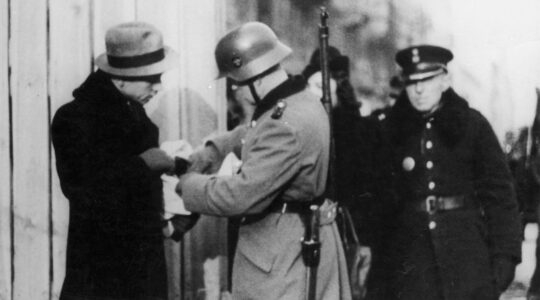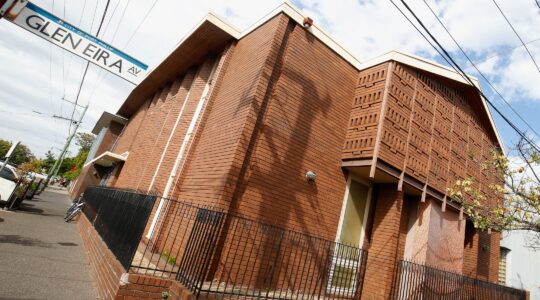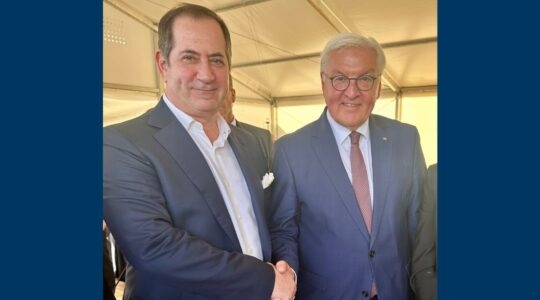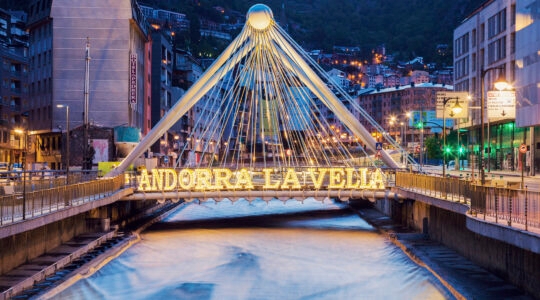
The Museum of Jewish History in Girona stands as testament to the completeness of Spain’s destruction of its once-thriving Jewish population. (Ben Harris)

Assumpcio Horsta, general secretary of Red de Juderias. (Ben Harris)
GIRONA, Spain (JTA) — Hidden among the maze of alleyways east of the Onyar River, the Museum of Jewish History stands as testament — if an inadvertent one — to the completeness of Spain’s destruction of its once-thriving Jewish population.
Inside the museum, set in what is said to be Girona’s last known synagogue, designers have layered the ancient architecture with all the flourishes of a contemporary museum, complete with glass-lit cases, multimedia displays and an audio tour in several languages.
In one case sits the signet ring belonging to Girona’s most famous Jewish son, Rabbi Moses Ben Nahman Girondi, the legendary Judaic scholar known as the Ramban or Nahmanides.
The sight of the ring inspires the kind of spine-tingling intimacy with history that museums like this aim to evoke — that is, until the voice on the audio guide announces that the ring is a fake, a copy of the original that sits in a museum in Jerusalem.
In fact, most of the artifacts in Girona are copies. Virtually nothing is left from the community that once lived here, save for the tombstones excavated from the nearby Jewish cemetery. The few artifacts from the period that have survived are generally beyond the museum’s financial ability to acquire.
“Once in a while we can buy something, but it’s not as often as we would like,” said Assumpcio Hosta, the director of Patronat Call de Girona, the municipal body responsible for the preservation of Girona’s Jewish heritage. “It costs a lot of money.”
That difficulty hasn’t stopped nearly two dozen cities and towns throughout Spain from trying to capitalize on their Jewish history, building monuments and hosting concerts, lectures and other cultural activities inspired by one of the most productive and accomplished Jewish communities in history.
The effort has left some Jews feeling that Spain is exploiting a history that rightfully belongs to contemporary Spanish Jews, and in the process is relegating a living culture to a museum piece by portraying Judaism as little more than a historic curiosity.
The primary purpose of establishing the Spanish Jewish heritage sites is to attract tourism to areas that otherwise have little to recommend them as holiday destinations.
“The government is using the Jewish patrimony for a purpose, and the only real purpose is to bring tourism to Spain,” said Rabbi Dovid Libersohn, the Argentina-born Chabad rabbi in Barcelona. “Some politicians, they like Judaism without Jews.”
But Spanish officials involved in the effort to highlight Jewish heritage say it’s not a fair or apt analysis. They note that the Spanish government has devoted resources to rebuilding its ties with Israel and with Jewish communities, in Spain and beyond. In 2006, Spain established Casa Sefarad-Israel, an agency of the Ministry of Foreign Affairs charged with promoting good relations with Spanish Jewry, the global Jewish Diaspora and the State of Israel.
Within Spain there is Red de Juderias, a network of nearly two dozen Spanish cities and towns whose official purpose is to preserve the cultural legacy of Jewish Spain but whose main aim is to promote tourist sites.
The development of Jewish heritage sites in Spain is part of a wider explosion of interest in the culture of Europe’s lost Jewish communities.
Institutions such as the European Association for the Preservation and Promotion of Jewish Culture and Heritage and Warsaw’s Museum of the History of the Polish Jews, and annual events like the European Day of Jewish Culture and the Jewish Culture Festival in Krakow, work to restore the Jewish place in the pantheon of European minorities. Most of these efforts are intended mostly for non-Jews, who often are the organizers.
Red de Juderias, which along with B’nai B’rith Europe co-organizes the European Day of Jewish Culture, is run in the typical manner of European bureaucracies. It has a presidency that rotates among its members and glossy, full-color brochures printed on heavy stock. The network encompasses large cities such as Toledo, which already is a major tourist destination, and smaller towns like Besalu and Caceres, which aspire to be. More recently it established a tourist brand, Rasgo, to help direct visitors to restaurants, hotels and guides that highlight Jewish heritage.
“That heritage belongs to every citizen,” said Hosta, who also is the general secretary of Red de Juderias. “It doesn’t belong to a single part of the community. That’s our common heritage.”
But some segments of Spain’s small Jewish community say Jewish heritage doesn’t belong to the descendants of those who expelled the Jews 500 years ago, but to the Spanish Jewish community of today — even if the bulk of the country’s Jews are relatively recent arrivals from elsewhere, principally Argentina and North Africa.
They contend that Spain is exploiting Jewish history for a profit while often minimizing Spain’s own culpability in bringing that history to an abrupt end. The museums and conferences and concerts and cooking demonstrations collectively present Judaism as a kind of ersatz culture divorced from a living faith.
“The way they represent Judaism is very poor,” said Dominique Tomasov Blinder, a Barcelona-based architect and founder of Urban Cultours, a tour company focused on the Jewish heritage of Catalonia.
“It’s a sterile collection of objects, displayed like little trophies, that were rescued from the flood of the expulsion,” Blinder said. “If we had not been kicked out, all these objects would be in our synagogues, in our yeshivot, in our study centers, in our schools, our homes. And they would have a life, a purpose to be.”
As evidence that Spain’s priorities are misplaced, critics of the country’s approach to Jewish heritage note that while much enthusiasm exists for cultural festivals and the like, local governments seem willing to trample on Jewish cemeteries.
In Barcelona, efforts to erect tourist facilities on the old Jewish cemetery on Mont Juic were halted, but only after a battle. In Toledo, once the epicenter of Jewish life in Spain, the construction of a school over the remains of a medieval Jewish cemetery sparked an international uproar, leading in 2009 to an uneasy compromise.
Meanwhile, surveys show that Spain ranks among the European countries with the highest anti-Semitic metrics. A 2002 study by the Anti-Defamation League asked residents of five European countries questions about their perceptions of Jews, including whether Jews have too much power and are more loyal to Israel. Spain topped in every category.
More recently, a 2008 Pew study found that 46 percent of Spaniards viewed Jews unfavorably — the highest number in Europe and 10 percentage points higher than Poland, the next highest European country.
Diego de Ojeda, the director of Casa Sefarad-Israel, chalks this up to basic ignorance: Because there are so few Spanish Jews today, most Spaniards have never encountered a Jew in their lives. In an interview in his Madrid office, de Ojeda recalled once asking a taxi driver to take him to “la sinagoga,” and the driver asked if that was the name of a new restaurant.
Casa-Sefarad Israel has brought a popular Spanish pop group to Israel for a concert and to film a video in the desert near the Dead Sea, and has helped start public celebrations of Chanukah in Madrid, something the local community failed to do on its own.
“There’s not a conspiracy in Spain to say let’s dig out our Jewish past so we can milk Jewish tourists,” de Ojeda said. “That’s also a part of it. But it’s the right thing to do. We do it with our Arab culture. We do it with our Roman remains. We do it with any archaeological remains.”
For Jews living in Spain today, the few vestiges of Jewish life that remain are of more than archaeological significance. They are tangible manifestations that a vital community once lived here, and help establish continuity between that community and the one that has begun to re-establish itself over the past century. Today, most of the country’s Jews live in Barcelona or Madrid, and there are smaller communities in a half-dozen other spots around the country.
Critics of Girona and similar projects are generally vague about what exactly they would do differently. They recognize the limitations under which well-intentioned non-Jews seeking to preserve Jewish heritage are operating, given that virtually all the member cities of Red de Juderias have no local Jewish communities with which to consult. And they acknowledge that they are relative newcomers to Spain, with little — and arguably less — direct connection to medieval Spanish communities.
David Stoleru, a French-Israeli architect living in Spain for nearly 15 years who has been involved in the fights over preserving Jewish cemeteries, says the real question is not who owns history, but whether it is made relevant and meaningful. And at a time when European identity is in flux, and the continent continues to grapple with the place of restive minority populations, Spain is squandering an opportunity to learn from its Jewish past.
“When Spaniards tell you it’s their own heritage after kicking out Jews 500 years ago, it’s a complex situation,” Stoleru said. “But of course those Jewish people living and dying here, they weren’t living on the moon. They were part of this context. The idea is how to re-inscribe this history in this context. That is the challenge.”
JTA has documented Jewish history in real-time for over a century. Keep our journalism strong by joining us in supporting independent, award-winning reporting.





